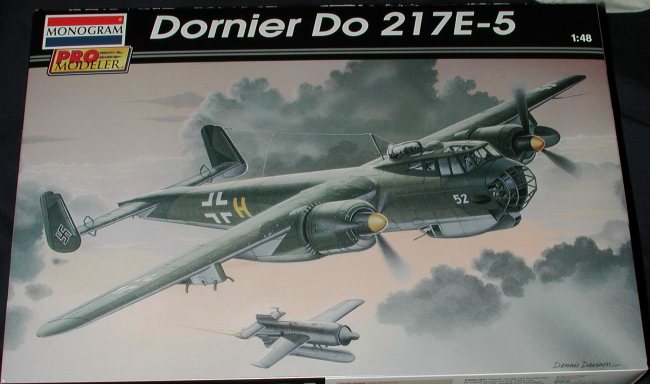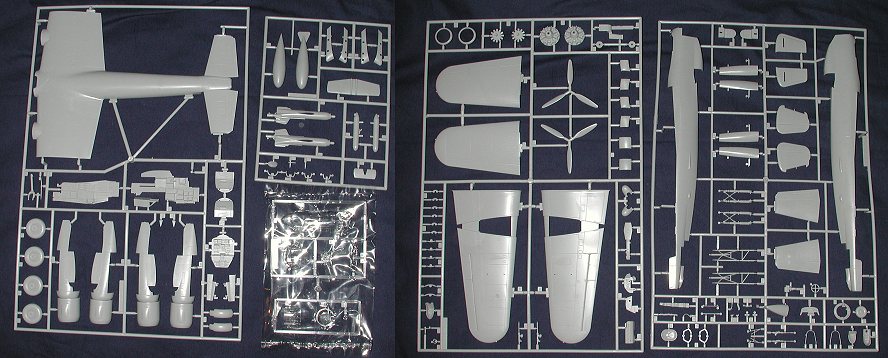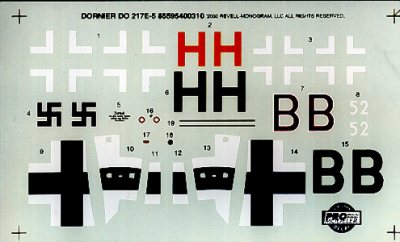
|
KIT: |
ProModeler 1/48 Do-217E-5 |
|
KIT # |
5954 |
|
PRICE: |
$32.95 |
|
DECALS: |
Two aircraft, see review |
|
REVIEW & |
|
|
NOTES: |

|
HISTORY |
Developed from the earlier Do-17 'Flying Pencil, the Do-217 was upgraded to a heavy bomber capable of carrying heavier loads a greater distance. This was largely due to the increased power of the engines as well as greater fuel capacity. The prototype, powered by DB.601 engines, first flew in late 1938. However, despite the similarity in design with the Do-17, it was not as pleasant an aircraft to fly, having poor directional stability, sluggish controls and a tendency to swing during takeoff. These characteristics obviously helped lead to its early demise during testing.
The next prototypes were Jumo 211 powered and tested the large tail mounted airbrake. This was not a success and was not used in production aircraft. Testing of other prototypes continued through 1939, some equipped with BMW 139 radial engines. It was later decided to switch to the improved BMW 801 engines and after a short run of unsuccessful Do-217A and Do217C aircraft, the prototype for the Do-217E, the v9, was flown in early 1940. This was the aircraft that the Luftwaffe was looking for and an initial production Do-217E-0 left the assembly line in the fall of 1940, followed by E-1s later in the year.
The E-1 was designed as a level bomber/anti-shipping bomber. There were also some photo recce aircraft which had cameras in the bomb bay. These aircraft were sent to Romania to start secretly photographing Soviet territory early in 1941. The first unit to take the E-1 into action was KG.40, using it for anti-shipping strikes in March of 1941. The E-3 increased defensive armor and armament and a 20mm cannon was installed in the nose for strafing shipping. The E-2, developed around the same time, was to be the dive bomber version with dive brakes installed. These aircraft were sent to Stuka group 2 in the fall of 1941 and proved to be less than satisfactory for the role. Most Do-217E-2 units simply removed the tail brakes and substituted a standard tail cone. The RLM finally admitted defeat and abandon all additional attempts at making this plane into a dive bomber.
Late in 1941 the Do-217E-4 was rolling off the assembly lines and by the early 1942 was in squadron service. This had several improvements in power and crew stations. A small number of E-4s were modified to carry the Hs-293 stand-off missile, these aircraft being designated D0-217E-5. These missiles were guided from a small control stick in the bombardier's compartment and emitted smoke to help the controller see the missile. The FX 1400 missile was also carried by this version. The Hs-293 missiles were quite effective, destroying several Allied destroyers in the Bay of Biscay during 1943.
|
THE KIT |

I have been told that this kit looks very much like the superb vacuform developed by Bill Koster. And so it should as he also designed this kit. For you that want to do other versions, just hang on as Bill told me that there are some conversion sets in the works. As one would expect from R-M, the kit is a superb piece of engineering. Usual state of the art engraved surfaces and lots of bits and pieces to make a very accurate kit right from the box. I has much of the feel of the Ju-52 and He-111 kits produced under the ProModeler label.
Looking the kit over, I saw no sink marks, no flash and only a few ejector pin marks in embarrassing places, like the insides of the wheel well. While they don't look that easy to fix, they are pretty much out of normal sight. The rest are easy to clean up or will not be seen at all once the kit is constructed.
As expected, detailing is quite complete, though I am sure that the aftermarket people will soon have all sorts of resin and photoetched stuff for you to spend your money on. There are only two parts of the kit that I can see might cause any problems. One is the engine nacelles. These are split right and left instead of being a single molding. I'm sure this was done for ease of molding. There is a small front cowl ring to help cover up any gaps from construction. The other is the cockpit transparency. This is a very complicated mold. There are two triangle shaped pieces that fit onto the side of the canopy and there is the power turret that fits on the top. Getting all this to mate together is a rather complicated affair according to the instructions. Care will be needed when doing this. The instructions also suggest painting the kit prior to gluing on the clear bits. This might not be such a bad idea with this kit.
 Speaking of instructions, they are
the usual superb ProModeler ones. While there are no photos of the real plane (I
don't think one exists), the steps are clear and concise. There are the usual
tips, most of which deal with drybrushing the interior. All parts that need
painting have the color clearly marked. Those assembly steps which need a clear
sequence of part installation are also clearly marked. I like this particular
feature and wish more offered this advice.
Speaking of instructions, they are
the usual superb ProModeler ones. While there are no photos of the real plane (I
don't think one exists), the steps are clear and concise. There are the usual
tips, most of which deal with drybrushing the interior. All parts that need
painting have the color clearly marked. Those assembly steps which need a clear
sequence of part installation are also clearly marked. I like this particular
feature and wish more offered this advice.
Decals are for two aircraft, both of II./KG 100 and allegedly of aircraft that participated in the sinking of the destroyers in the Bay of Biscay in August 1943. Both have the maritime scheme of RLM 72/73 upper with RLM 65 lower surfaces. One of the aircraft has a scribble pattern over the camouflage done in RLM 76. The Hs-293 missile is in the underside color of RLM 65 according to the instructions. It could also be in RLM 76, but it does make sense that it would be painted to match the underside of the aircraft carrying it. The sheet itself is a ProModeler sheet and not one by Scalemaster. That means it is in register! The underside crosses are in several parts to fit over the missile and fuel tank pylons, a very nice touch. I have never used ProModeler decals so do not know how they will respond to setting solutions.
Overall, another winner from Revell. As to doing different variants, you can bet that Bill Koster will have some aftermarket sets to do the night fighter as well as the liquid cooled engine Do-217Ks. If you like the Luftwaffe, have room in your display case and want a very nice kit, then this is it!
|
REFERENCES |
Warplanes of the Second World War; Bombers and Reconnaissance Aircraft, Volume 9, by William Green, 1967, Doubleday
Review kit courtesy of me and my wallet!
If you would like your product reviewed fairly and quickly by a site that has over 1,500 visits a day, please contact me or see other details in the Note to Contributors.